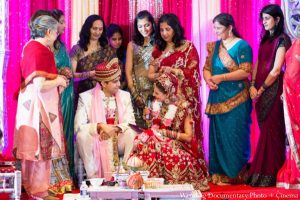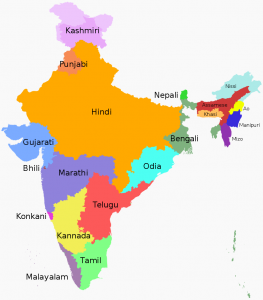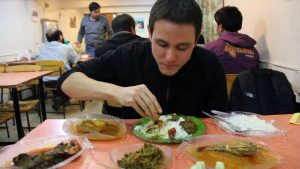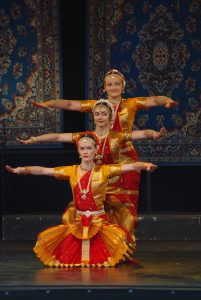Exploring India Through the Eyes of a South African: Indian Culture & Customs
India is one of the oldest civilizations in the world, and is definitely one of the most unique cultures in existence. Indian culture collectively refers to the diversity within every community. Languages, religions, pop culture, food, and customs all differ from one place to another. The South, North, and Northeast of India each have their own distinct cultures and almost every state has shaped its own cultural niche, and this assortment spans every division of Indian culture.
Religion/Spirituality:
India is known as the land of spirituality and philosophy, and was the birthplace of some of the world’s major religions. Although there are times when the communities are at odds with each other over their religious differences, for the most part they live in complete harmony. My personal spirituality has been deeply influenced by how inspirational Indian philosophy is.
India boasts many diverse religions, some of which are Buddhism, Islam and Christianity, but the most widely practised is Hinduism. Hindu temples are a familiar sight throughout the country, and many practices from Hinduism have become a central part of Indian culture. Even so, the streets of India are marked with many colourful shrines, majestic temples, decorated churches and mosques, and other places of worship.
India is notorious for their exuberant festivals that take place throughout the year, such as Diwali, Ganesh Chaturthi, and Holi to name a few. Festivals in India are embodied by colour, vivacity, zest, prayers and rituals. Indians know how to celebrate – I’ve lost many nights of sleep due to endless processions and festivals!

One of the most interesting facts about these celebrations, is how many people take part in all the festivities, whether or not they follow that religion. For instance, being raised a Christian and married to a Muslim – my husband and I have taken a more liberal approach to spirituality, and when we visit India his family celebrates many Hindu holidays – and even incorporated a few rituals into our Nikkah!
Social:
Indian society was traditionally based around a caste system, which placed unbending restrictions on social progress and the ease with which people of different castes could interact with each other. However, over the last 50-60 years the Indian government has progressively approved laws to highlight a more modern outlook and to promote and support social welfare and equality.
Family values are a significant part of Indian life. Arranged marriages are very common, and marriage in general is taken seriously – resulting in an extremely low divorce rate. It is ordinary to see large, patriarchal families spanning many generations. Many businesses are likely to be family-run and owned, and there will be a preference for employing other family members where possible. Believe me when I say, everything in India is a family affair. Since one half of my family is now Indian, it took some getting used to the “helicopter families” that India is so accustomed too. “Helicopter” meaning hovering! Indian millennials are accustomed to having families involved in every part of their lives, while in west its quite dissimilar.

Language:
India has 22 official languages, and the total number of mother tongues spoken in India is over 1,500. It’s a mouthful! However, only around 150 languages have a substantial speaking population. The most commonly spoken languages are Hindi and English. Notable languages include Tamil, Bengali, Marathi, Gujarati, Malayalam, and Punjabi.
Due to British influence, English is spoken mainly in the industries of education, government, and business. Throughout most of India, Hindi is without question the most widely spoken, however in the South there has been some hesitation to Hindi being the national language, with many feeling that it will fade out their languages. As a result, in South India, English is the more frequently used of the two languages.
If you are visiting India, it would be helpful to research which languages are spoken in the areas that you are visiting. Familiarizing yourself with a few words or greetings will stand you in good stead. Trust me – it’s easier than you think. I’ve picked up rather a lot of Hindi during my stays in India, since my in laws can’t speak a lot of English. But as a rule of thumb when speaking to many locals – speak slowly. I often rattle on and find my husband taking over in Hindi!

Etiquette:
Indian etiquette is an incomparable mixture of British and Asian influences. Therefore, in some ways their customs will seem familiar to Westerners, and in other ways differ greatly. Being a South African, the transition was effortless since many Indians live in South Africa, unlike for many foreigners who aren’t accustomed to certain aspects of Asian culture.
This is especially true when it comes to the way Indian’s eat – which is of course with their hands. It is considered suitable to eat with your hands, and in many traditional restaurants or when you are eating with locals, though cutlery is usually provided. Want to give it a try? Make sure you only use your right hand and not your left – even if you are left-handed, as the left-hand is seen as unhygienic. I now enjoy a happy medium of Indian culture and my culture – and when in India, I eat with my hands.

It’s good manners to take your shoes off before entering someone’s home, and it’s a definite must before entering a temple or mosque. Indians usually wear shoes inside their homes – coming from the South African bush, I’m a barefoot gal indoors – or when going to the bathroom. However, these shoes are kept for indoors and are never worn outdoors. Sometimes, shoes are removed before entering a shop. If you see shoes at an entrance, it’s respectful to take yours off too.

PDA is a no-no! While you may think nothing of holding your partner’s hand in public, or even hugging or kissing them, it’s not appropriate in India. India is conservative, specifically the older generation. Public affection is frowned upon and considered indecent. While it’s unlikely that a foreigner would get arrested, it’s best to keep affectionate gestures private. And as they say, ‘absence makes the heart grow fonder’!

Pop Culture:
Art, literature, film, and architecture have thrived in India for centuries and I often find myself in awe when it comes to Indian pop culture. India is famous for being the home country of a large number of brilliant artists, writers, singers, and actors. It is heavily influenced by its rich civilization and there is something to admire in every street.

Special status should be given to Indian art and its various forms. The art work of this country boasts classic-style paintings, moving street art, impressive architecture, rangoli, pottery, and textile arts like woven silk, and has received global praise. A fascinating element of Indian pop culture is the street art – a personal favourite being the graffiti in Chapel Road, Bandra, Mumbai.

Indian pop culture would be half-finished if I neglected Bollywood. The Hindi movie industry, popularly known as ‘Bollywood’, has influenced daily life and culture in India for decades. In fact, movies are the backbone of entertainment and are almost a religion in the nation. Bollywood films are perhaps the best modern-day guide to understanding what moves the hearts of Indians, and what values Indians support as their own. In fact, Bollywood is one of the largest epicentres of film production worldwide. Many of them have English subtitles too – bonus! I’ve spent many a date night, cuddled up watching some of my favourite heroes and heroines!

Music is an integral part of Indian culture – both socially and spiritually, with singing and dancing being a collective form of expression during festivities and celebrations. India is a land of diverse dancing and musical genres, with both classical and folk interpretations. People dance and sing on just about any occasion like the birth of a child, festivals, harvesting seasons, wedding events, etc. When I visit India, I switch into a mode where I can sleep through just about anything. Indian people would never pass up the opportunity to celebrate – they give the Western party animals a run for their money!

Indian culture is a composite assortment of varying styles and influences. A fusion of deeply rooted traditions and ethnically-rich customs. Many elements of the diverse cultures have an overwhelming impact across the world, and they certainly have an impact on me – I have a deep admiration for Indian culture having seen it all up close. My soul is connected to the roots of Indian customs and the passionate approach people live their lives here.
You might be wondering why I haven’t divulged the culinary part of Indian culture – stay tuned for my final post in this series on perhaps the most enticing post yet. I won’t leave out any delicious details.
This blog post is 3rd part of the series Exploring India through the eyes of a South African
Part 1 : Places I visited. https://blogsinmyemail.com/index.php/2018/02/07/exploring-india-eyes-south-african-places-visited/
Part 2 : My experiences in India. https://blogsinmyemail.com/index.php/2018/02/14/my-experiences-in-india/
